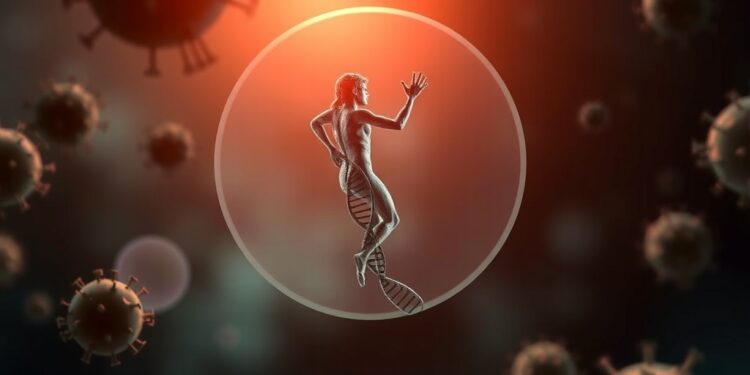
The Revival of Ancient Viral DNA: Unmasking Its Vital Role in Mammalian Embryo Development
In recent decades, the field of genetics has undergone a profound transformation, especially regarding the enigmatic segments of our DNA known as transposable elements. Once relegated to the status of “junk DNA,” these sequences, originating from ancient viral infections, have been found to wield significant influence over the machinery of gene expression. Researchers at Helmholtz Munich and Ludwig-Maximilians-Universität (LMU) have made groundbreaking discoveries elucidating the roles of these ancient viral remnants in early embryo development. Their studies reveal an intricate interplay between these transposable elements and the cell’s adaptive potential during the crucial phases following fertilization.
Transposable elements are segments of DNA that can change their position within the genome, a property that allows them to exert influence over nearby genes. Their history traces back to viral infections that occurred millions of years ago, embedding bits of viral DNA into the genomes of host organisms. It’s estimated that more than half of the human genome comprises these sequences, which, despite their abundance, remain shrouded in mystery. The research community has long sought to decode their functions, particularly during significant biological processes like early embryonic development, where cell fate determination is of paramount importance.
During the initial hours and days post-fertilization, embryonic cells exhibit remarkable plasticity, a trait essential for various developmental pathways. However, the regulatory factors and molecular mechanisms underpinning this plasticity have remained largely ambiguous. While studies in mouse models have hinted at a potential role for transposable elements in driving cellular plasticity, the universality of this phenomenon across different mammalian species was yet to be established. Understanding how these ancient viral remnants contribute to cellular behavior is vital, not only for unveiling the principles governing genome regulation but also for advancing fields like reproductive medicine.
In a pioneering effort to explore these ancient sequences, a team led by Prof. Maria-Elena Torres-Padilla embarked on a research project that utilized cutting-edge methodologies to map transcription activities of these elements in mammalian embryos. Their innovative approach involved the construction of a single-embryo atlas, comparing cellular activity across diverse mammalian species such as mice, cows, pigs, rabbits, and rhesus macaques. The team’s unexpected findings revealed that these purportedly extinct viral elements were re-expressed during the embryonic phases, suggesting that the activation of these elements is a conserved feature across species.
The analysis further illuminated that distinct mammalian species exhibited varying types and patterns of transposable element expression. This discovery signifies a more complex interaction between these ancient sequences and species-specific genome architecture than previously understood. The activation of transposable elements appears to be a foundational aspect of early embryonic development rather than an isolated peculiarity, indicating evolutionary advantages that these elements confer to cellular adaptability.
From a practical standpoint, this research heralds new avenues for gene manipulation and cellular biology. The ability to identify and harness specific transposable elements opens up remarkable possibilities for influencing gene expression en masse. Researchers are now poised to deploy these elements in pioneering strategies aimed at directing pathways such as stem cell differentiation, an area that traditionally necessitates the painstaking manipulation of multiple genes individually. This newfound efficiency could revolutionize biological research, enhancing our understanding of cellular fate determination and offering therapeutic insights.
As Prof. Torres-Padilla articulates, the activation of transposable elements in early embryos represents a unique hallmark of mammalian development. Given the pluripotent nature of these early-stage cells—which can differentiate into various cell types—understanding the regulatory mechanisms that govern these viral remnants becomes crucial. This knowledge may eventually elucidate pathways to enhance regenerative medicine therapies, improve reproductive health strategies, and provide insights into developmental disorders.
The research team has not only provided vital insights into the role of transposable elements but also compiled an invaluable dataset that details the dynamics of early embryo development across multiple mammalian species. By employing an evolutionary perspective, the findings contribute to a collective understanding of fundamental regulatory pathways that are conserved across diverse organisms, challenging the prevailing notion that developmental processes are too species-specific to draw broad conclusions.
Moreover, this study underscores the importance of collaborative research efforts that integrate findings from various species, creating a more comprehensive understanding of gene regulation during embryogenesis. As scientists continue to dissect the complexities of life processes, collaborative frameworks will be crucial in bridging gaps and accelerating discoveries that have far-reaching implications for biology and medicine.
The profound repercussions of these findings extend well beyond academic curiosity. In an age where genetic engineering and regenerative medicine are at the forefront of scientific inquiry, deciphering the roles of these ancient viral sequences is poised to reshape how we approach genetic diseases, developmental biology, and therapeutic interventions. Moving forward, researchers are called to delve deeper into these regulatory elements, transforming our understanding of life at its most fundamental level.
By drawing from a rich repository of evolutionary data and integrating innovative experimental methodologies, this research paves the way for addressing critical challenges in genetic and developmental sciences. As scientists decode the layers of complexity embedded in our genomes, the promise of transposable elements as versatile regulatory mechanisms offers exciting prospects for future research.
In summation, the recent revelations regarding ancient viral DNA and its vibrant role in mammalian embryonic development invite a re-evaluation of our understanding of genetic regulation. This journey into the genetic past not only enhances our comprehension of developmental biology but also unveils pathways for future scientific endeavors, ultimately broadening the horizons of what is possible in genetics, medicine, and biotechnology.
Subject of Research: The role of transposable elements in early mammalian embryo development.
Article Title: An atlas of transcription initiation reveals regulatory principles of early mammalian development.
News Publication Date: October 2023.
Web References: Not applicable.
References: Not applicable.
Image Credits: Not applicable.
Keywords: Viral DNA, Stem cell research, Transposable elements, Evolutionary developmental biology.





